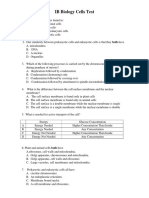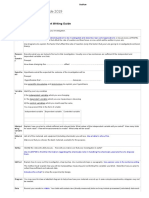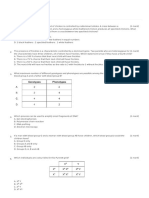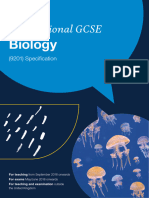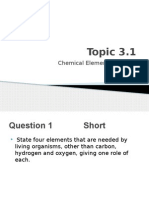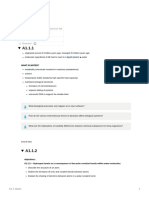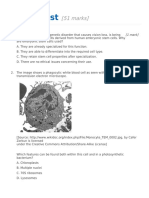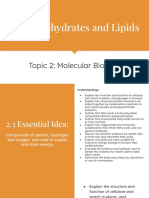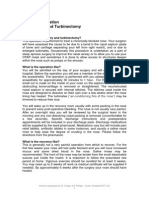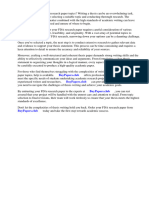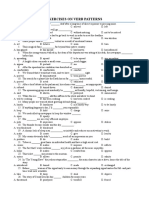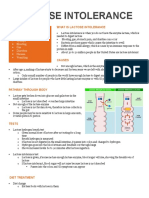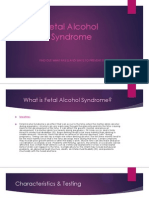IB BIOLOGY TOPIC 1 Questions
IB BIOLOGY TOPIC 1 Questions
Uploaded by
Sarah MasonCopyright:
Available Formats
IB BIOLOGY TOPIC 1 Questions
IB BIOLOGY TOPIC 1 Questions
Uploaded by
Sarah MasonOriginal Description:
Copyright
Available Formats
Share this document
Did you find this document useful?
Is this content inappropriate?
Copyright:
Available Formats
IB BIOLOGY TOPIC 1 Questions
IB BIOLOGY TOPIC 1 Questions
Uploaded by
Sarah MasonCopyright:
Available Formats
Topic 1 Questions:
1. What functions are carried out by unicellular organisms? Response, homeostasis, metabolism, growth
2. What is an example of the therapeutic use of stem cells?
3. What distinguishes prokaryotic cells from eukaryotic cells?
4. What substance is used for structure in plants?
5. An unknown cell observed using microscope. A cell wall, ribosome and DNA are identified what can be
concluded?
6. Red blood cell is 8 micrometers in diameter. If drawn 100times larger than actual size, what is the diameter?
7. What is proportional to cell’s surface area?
8. What are stem cells
9. What is the function of membrane proteins?
10. Where are proteins synthesised by free ribosomes used?
11. What describes nuclear division in stem cells?
12. What evidence falsifies Davson-Danielli model? (Membrane structure)
13. What makes stem cells suitable for therapeutic use?
14. What is the function of plant cell wall?
15. What features of a cell favour efficient removal of waste products? (SA:V)
16. What is the difference between prokaryote and eukaryote cells?
17. What happens to cell SA to V ration as cell grows?
18. What is an example of binary fission?
19. What are the 3 main functions of membrane proteins?
20. Which process is possible due to fluidity of cell membranes?
21. What is the role of these glycoproteins in animals?
22. How do prokaryotic cells divide
23. What is the approximate thickness of the plasma membrane of a cell?
24. What causes cell differentiation?
25. During what phase of the cell cycle do chromosomes duplicate?
26. What is the difference between a cell in G1 phase and a cell in G2 phase in cell cycle?
27. What actions occur during interphase?
28. During which stage does cell SA:V ratio decrease?
29. What 2 processes take place during interphase in animal cells?
30. How do cells in multicellular organisms differentiate?
31. What are the exceptions to cell theory?
32. Which features are present in prokaryotic cells? DNA, cell wall, Pili
33. Which feature are present in eukaryotic cells?
34. Which three functions are carried out by ALL unicellular organisms?
35. What structures are part of Escherichia coli cell?
36. What is evidence for endosymbiotic theory?
37. Which 2 processes take place during interphase and mitosis in animal cells?
38. What is the function of the cytoplasmic (plasma) membrane of this bacterium?
39. Identify stages of mitosis using diagrams
40. Identify each movement across a membrane (Identify membrane structures and their function)
41. Structure of a paramecium
42. Salt con. Inside paramecium is 1.8% compared to 0.2% outside. What will be the likely response?
43. What route is used to export proteins from the cell? rough end reticulum —> golgi apparatus —>plasma
membrane
44. What even occurs during both mitosis and meiosis?
45. What is the role of cholesterol in animals? = controls membrane fluidity
46. What events occur during the G1 phase and s phase? Cell grows, DNA, replicates
47. What organism has DNA located in 3 organelles? fern
48. Why do multicellular organisms have emergent properties? they show properties that can only result from
interaction of many cells
49. What is osmosis
1. Discuss possible exceptions to cell theory. 4 marks
2. Eukaryotic cells have intracellular and extracellular components. State the functions of one named
extracellular component. 4 marks
3. Explain how the surface are to volume ratio influences cell sizes. 3 marks
4. Outline differentiation of cells in a multicellular organism. 4 marks
5. Describe the importance of stem cells in differentiation. 3 marks
6. Draw a labelled diagram to show the ultrastructure of Escherichia coli. 6 marks
7. Draw a labelled diagram to show the organelles which are found in the cytoplasm of plant cells. 6 marks
8. State one function of each of the following organelles: lysosome, Golgi apparatus, rough endoplasmic
reticulum, nucleus, mitochondrion. 5 marks
9. Draw a labelled diagram showing the ultra-structure of a liver cell. 4 marks
10. Distinguish between the structure of plant and animal cells. 6 marks
11. Using a table, compare the structures of prokaryotic and eukaryotic cells. 5 marks
12. Describe the process of mitosis
13. Describe the process of meiosis
14. Outline cell theory
15. Describe the genetic code and its relationship to polypeptides and proteins
16. Outline the role of proteins in active and passive transport of molecule through membranes
17. Explain how ATP is generated in animals
18. Outline the endosymbiotic theory
19. Outline the various stages of the cell cycle (4)
20. Define transpiration and explain factors that can affect transpiration in plants (9)
21. Describe the characteristics of stem cells that make them potentially useful in medicine (5)
22. Outline a technique of gene transfer resulting in genetically modified organisms (5)
23. Explain the use of Karyotyping in human genetics (8)
24. Explain how minerals move into plants (8)
25. Outline the conditions needed for germination of a typical seed (3)
26. Following germination of seeds plants undergo a rapid increase in number of cells describe stages in the cell
cycle that results in this (7)
27. Draw and label diagram to show structure of plasma membrane (5)
28. The light dependent reactions in photosynthesis take place on the thylakoid membranes. Explain the light-
dependent reactions. (8)
29. Outline two factors that affect rate of photosynthesis (5)
30. Draw and label diagram of the ultrastructure of E-coli as an example of a prokaryote (4)
31. Describe the events that occur in the four phases of mitosis in animals (6)
32. Explain process of aerobic cell respiration after glycolysis has occurred (8)
33. Draw and label diagram to show the molecular structure of a membrane (4)
34. Some proteins in membranes act as enzymes. Describe a model that accounts fo the ability of enzymes to
catalyse sections (6)
35. Membrane of pre-synaptic and post synaptic neurones play an important role in transmission of nerve
impulses. Explain the principles of synaptic transmission (8)
36. Draw a labelled diagram that shows the positions of proteins within the cell membrane (3)
37. Outline effects of putting plant tissue in a hypertonic solution (4)
38. Explain how structure of nephron and its associated blood vessel enable the kidney to carry out its function (8)
39. Explain how chemical energy for use n the cell is generated by electron transport and chemiosmosis (8)
40. Outline 4 different functions of membrane proteins (4)
41. Distinguish between anabolism, catabolism and metabolism (3)
42. Describe 4 different types of transport of substances across a membrane (4)
43. Hormone such as FSH and LH affect the development of certain cells by binding to receptors in the plasma
membrane. Outline the role of FSH and LH in the menstrual cycle (6)
44. In the placenta, many substances are transported across membrane. Explain structure and role of the
placenta (8)
45. Draw a labelled diagram of the ultrastructure of a prokaryote (4)
46. Explain the process of DNA replication (6)
47. Outline how the structure of the ribosome is created to its function in translation (8)
48. Draw a labeled diagram to show structure of a sarcomere (5)
49. Explain how an impulse passes along the axon of a neurone (8)
50. Describe the process of endocytosis (5)
51. Outline transcription in prokaryotes (6)
52. Some prokaryotes cause infectious diseases in humans. Explain the principle of vaccination (8)
53. Outline, with an example, the process of exocytosis
54. Translation occurs in living organisms. Explain how translation is carried out (9)
55. Some prokaryotes cause infectious diseases which stimulate the body immune system. Outline the principles
that form the basis of immunity. (6)
56. Draw a labelled diagram showing the ultra-structure of a liver cell (4)
57. Distinguish between prokaryote sand eukaryotic cells (6)
58. Explain prokaryotic DNA replication (8)
59. Distinguish between active and passive movements of material across plasma membrane (4)
60. Explain how chemiosmosis assists in ATP production during oxidative phosphorylation
61. Explain the control of gene expression in eukaryotes
62. Define osmolarity
You might also like
- IB DP Bio - A 2.2 Cell Structure - Student NotesDocument26 pagesIB DP Bio - A 2.2 Cell Structure - Student NotesannaninaibNo ratings yet
- 12 - IB Biology 2023 New Syllabus B2.2 Organelles and Compartmentalization PowerPointDocument59 pages12 - IB Biology 2023 New Syllabus B2.2 Organelles and Compartmentalization PowerPointmike bevnNo ratings yet
- DP Unit Plan-Biology - SampleDocument5 pagesDP Unit Plan-Biology - SampleAmal Jaber100% (1)
- Cell Test IB BIO HL 123Document7 pagesCell Test IB BIO HL 123AdamNo ratings yet
- Previous IB Exam QuestionsDocument12 pagesPrevious IB Exam QuestionsJohn OsborneNo ratings yet
- Inheritance Biology IGCSE WorksheetDocument2 pagesInheritance Biology IGCSE WorksheetJia Ru100% (3)
- Topic Test Oxfordaqa Int Gcse Biology 9201 Variation and EvolutionDocument10 pagesTopic Test Oxfordaqa Int Gcse Biology 9201 Variation and EvolutionNovanolo Christovori Zebua100% (2)
- Lab Report Guidelines For Ib in BiologyDocument5 pagesLab Report Guidelines For Ib in BiologyCheyenne AlvaradoNo ratings yet
- MYP Science 10: Lab Report Writing GuideDocument2 pagesMYP Science 10: Lab Report Writing GuideTiberiuNo ratings yet
- Louis Pasteur: by Jamie MignotDocument33 pagesLouis Pasteur: by Jamie MignotGiovanni BuzulanNo ratings yet
- DP1 BIO - Test - Topic 1 Paper 1 PDFDocument6 pagesDP1 BIO - Test - Topic 1 Paper 1 PDFSaima SyedaNo ratings yet
- DP Biology - Extended Essay Titles and Research QuestionsDocument2 pagesDP Biology - Extended Essay Titles and Research QuestionsshruthiNo ratings yet
- Molecular Biology Paper 1 - IB BiologyDocument6 pagesMolecular Biology Paper 1 - IB BiologyJohnathan ChargaffNo ratings yet
- Myp Chemistry Student ChecklistsDocument13 pagesMyp Chemistry Student ChecklistsKiran PandeyNo ratings yet
- D2.2 - HL Gene Expression Notes IB Biology HLDocument8 pagesD2.2 - HL Gene Expression Notes IB Biology HLitang1207No ratings yet
- Biology Notes IB Free ResponseDocument26 pagesBiology Notes IB Free ResponseLarry LohNo ratings yet
- MYP 3 Criterion D-MetallurgyDocument6 pagesMYP 3 Criterion D-Metallurgywama ojhaNo ratings yet
- Teacher(s) Sreekala.K.P Subject Group and Course Course Part and Topic SL & HL/Year 2 Dates 15Document9 pagesTeacher(s) Sreekala.K.P Subject Group and Course Course Part and Topic SL & HL/Year 2 Dates 15Nana Refaye100% (1)
- T3-1 T Biology Question BankDocument31 pagesT3-1 T Biology Question BankKunakorn KunthamasNo ratings yet
- IB Bio IA On Nuruk FermentationDocument9 pagesIB Bio IA On Nuruk FermentationGoeun Jeong (yr. 18-20)No ratings yet
- Biology Extended EssayDocument11 pagesBiology Extended EssayhunarsandhuNo ratings yet
- DP 2 Biology Theme UnitDocument3 pagesDP 2 Biology Theme Unitapi-246544437No ratings yet
- Digestion Questions Ib TEST PDFDocument8 pagesDigestion Questions Ib TEST PDFDaniela Duran80% (5)
- Ib Biology SLDocument68 pagesIb Biology SLShelley Lima100% (1)
- Grade 10 Unit 2 Assignment - Photosynthesis Factors.Document5 pagesGrade 10 Unit 2 Assignment - Photosynthesis Factors.MohdFahdelNo ratings yet
- IB-Biology-SL Ocs Revision GuideDocument1 pageIB-Biology-SL Ocs Revision Guidetg206No ratings yet
- MYP Biology Booklet # 3 Grade9 - MS1Document27 pagesMYP Biology Booklet # 3 Grade9 - MS1Aref Dahabrah100% (1)
- Cie Alevel BiologyDocument24 pagesCie Alevel BiologyArun Ghatan100% (2)
- IB Multiple Choice Past Paper Questions Topic 1 2012Document3 pagesIB Multiple Choice Past Paper Questions Topic 1 2012mamta2111No ratings yet
- SL Biology Syllabus NotesDocument52 pagesSL Biology Syllabus NotesRyel MuchunkuNo ratings yet
- IB HL Chemistry Study MaterialDocument25 pagesIB HL Chemistry Study MaterialelenaNo ratings yet
- Oxfordaqa International Gcse Biology SpecificationDocument44 pagesOxfordaqa International Gcse Biology Specificationdr.mohamed nabilNo ratings yet
- Biology Ib Questions Cells DocumentDocument3 pagesBiology Ib Questions Cells DocumentCosima Francesca ScheiblerNo ratings yet
- IB Biology Questions - Paper 2 Topic 3 QuestionsDocument19 pagesIB Biology Questions - Paper 2 Topic 3 QuestionsIB Blueprint100% (3)
- Introduction To Cells (1.1) :: The Cell TheoryDocument65 pagesIntroduction To Cells (1.1) :: The Cell Theoryelvira sta.mariaNo ratings yet
- Biology HL Exam QuestionsDocument120 pagesBiology HL Exam Questionsfasd100% (1)
- Calculating Magnification WorksheetDocument1 pageCalculating Magnification WorksheetMary Ann MaherNo ratings yet
- Criteria BCDocument9 pagesCriteria BCmar kh100% (1)
- Unit 1 - Topic 1 - Cell Biology - (11 HL and SL)Document32 pagesUnit 1 - Topic 1 - Cell Biology - (11 HL and SL)John DoeNo ratings yet
- Ib-Course-Planner - Yr 11 and 12Document12 pagesIb-Course-Planner - Yr 11 and 12abdullahiosman753No ratings yet
- A1.2 Nucleic AcidsDocument83 pagesA1.2 Nucleic AcidsGhenwa DimachkiNo ratings yet
- IB Biology Plant ScienceDocument26 pagesIB Biology Plant Sciencealekzi67% (3)
- Characteristics & Classification of Living Organisms: Assignment Biology SIBDocument18 pagesCharacteristics & Classification of Living Organisms: Assignment Biology SIBAnonymous pQ1Z6R29K9No ratings yet
- A1.2 Nucleic AcidsDocument5 pagesA1.2 Nucleic AcidslittleianlauNo ratings yet
- Atl Skills BiologyDocument3 pagesAtl Skills Biologytr4l100% (3)
- The Aga Khan Academy Hyderabad Summative Assessment Criteria B and C MYP4 ChemistryDocument3 pagesThe Aga Khan Academy Hyderabad Summative Assessment Criteria B and C MYP4 ChemistryJaimin Surani100% (2)
- Ib Course PlannerDocument11 pagesIb Course PlannerTijana Tosic100% (1)
- A1.2 2025 Topic Test v3Document5 pagesA1.2 2025 Topic Test v3valentinaNo ratings yet
- IB Biology Study NotesDocument134 pagesIB Biology Study NotesManav Parikh100% (4)
- Biology Myp SyllabusDocument3 pagesBiology Myp Syllabusapi-251156565No ratings yet
- Revision Questions On Enzymes WorksheetDocument2 pagesRevision Questions On Enzymes Worksheetminahils75% (4)
- IB HL Biology Photosynthesis NotesDocument3 pagesIB HL Biology Photosynthesis NotesTiffani Choy100% (1)
- A1 1 Water IB BIO - Notes (HL)Document5 pagesA1 1 Water IB BIO - Notes (HL)princessluna984100% (1)
- Practical Guide StudentsDocument24 pagesPractical Guide StudentsTina Atlagić100% (1)
- Biology Extended Essay Final Draft.Document33 pagesBiology Extended Essay Final Draft.Oliver Hernández100% (1)
- Topic 1 TestDocument11 pagesTopic 1 Testrania samirNo ratings yet
- 01 Ib Chemistry (SL+HL) - S1.1 Introduction To The Particulate Nature of MatterDocument58 pages01 Ib Chemistry (SL+HL) - S1.1 Introduction To The Particulate Nature of Matterricardochavezr100% (1)
- 2.3 Carbohydrates and LipidsDocument42 pages2.3 Carbohydrates and LipidsHelena GlanvilleNo ratings yet
- Flashcards - Topic 10 Diseases and Immunity - CIE Biology IGCSEDocument37 pagesFlashcards - Topic 10 Diseases and Immunity - CIE Biology IGCSEJane Lea100% (1)
- EHJ CVPT Article On Handbook - FINAL 1-4-19Document3 pagesEHJ CVPT Article On Handbook - FINAL 1-4-19chinmoysaha17No ratings yet
- Targeted Individuals 2nd Level CIA MIND CONTROLLING YOU Press Release WARNINGS To We The People ThewhiteroseiiDocument14 pagesTargeted Individuals 2nd Level CIA MIND CONTROLLING YOU Press Release WARNINGS To We The People Thewhiteroseiitina froidNo ratings yet
- ENT - Adult Septo-Turbs InfoDocument2 pagesENT - Adult Septo-Turbs InfoBayuLesmonoNo ratings yet
- Ileal Conduit Diversion Surgery PDFDocument28 pagesIleal Conduit Diversion Surgery PDFAnonymous XsuwLJNo ratings yet
- IELTS Master Reading & Listening Lesson 7: Matching & ClassificationDocument14 pagesIELTS Master Reading & Listening Lesson 7: Matching & ClassificationBảo ThúiNo ratings yet
- ImmunoglobulinDocument39 pagesImmunoglobulinReguird AllaeinniNo ratings yet
- AI Breast ScreeningDocument2 pagesAI Breast ScreeningChan Chee HouNo ratings yet
- Gardasil PiDocument29 pagesGardasil Pikalai87No ratings yet
- High-Intensity Interval Training: Loughborough University Institutional RepositoryDocument46 pagesHigh-Intensity Interval Training: Loughborough University Institutional RepositoryGytis GarbačiauskasNo ratings yet
- Care of HemophiliaDocument7 pagesCare of HemophiliaBasant karn100% (4)
- Https /app - Ieltsninja.com/quiz Test/5/336631/ Method PaperDocument11 pagesHttps /app - Ieltsninja.com/quiz Test/5/336631/ Method PaperBALKRISHNANo ratings yet
- FDA Research Paper TopicsDocument8 pagesFDA Research Paper Topicsnnactlvkg100% (1)
- Product Development FlanDocument12 pagesProduct Development FlanMariel MortaNo ratings yet
- Assisting With Dilatation and Curettage ProcedureDocument3 pagesAssisting With Dilatation and Curettage ProceduremanjuNo ratings yet
- How To Identify Adhd ChildrenDocument6 pagesHow To Identify Adhd ChildrenKUNNAMPALLIL GEJO JOHNNo ratings yet
- Compounding in Hospital SettingDocument22 pagesCompounding in Hospital Settingkhangsiean89100% (1)
- Preterm LaborDocument17 pagesPreterm LaborInd Matthew100% (1)
- Exercises On Verb PatternsDocument3 pagesExercises On Verb PatternsGia NhiNo ratings yet
- Lactose Intolerance Patient Education Handout 8th GradeDocument2 pagesLactose Intolerance Patient Education Handout 8th Gradeapi-368093620No ratings yet
- Concept of Public Health in Atharva VedaDocument27 pagesConcept of Public Health in Atharva VedaDr. JSR PrasadNo ratings yet
- Fetal Alcohol Syndrome PowerpointDocument8 pagesFetal Alcohol Syndrome Powerpointwelcome87No ratings yet
- KPOP Fans Should KnowDocument6 pagesKPOP Fans Should KnowmelissaNo ratings yet
- General Recall Paper 2 MrcsDocument79 pagesGeneral Recall Paper 2 MrcsMahbub RahmanNo ratings yet
- Influenza: It's Important To Note That Not Everyone With Flu Will Have A FeverDocument3 pagesInfluenza: It's Important To Note That Not Everyone With Flu Will Have A FeverUteNo ratings yet
- Bokuaka Fanfiction Sad???Document115 pagesBokuaka Fanfiction Sad???Auryn adya Callista putriNo ratings yet
- Premature Greying of Hair (White Hair) : Causes & Prevention TipsDocument3 pagesPremature Greying of Hair (White Hair) : Causes & Prevention TipsRidham GuptaNo ratings yet
- CHN1 Lec Session #17 SASDocument9 pagesCHN1 Lec Session #17 SASJhanna Mae BalbonNo ratings yet
- Adverse Event Following Immunization (AEFI) Manual of Procedures, 2014Document106 pagesAdverse Event Following Immunization (AEFI) Manual of Procedures, 2014Jezza Jonah AclanNo ratings yet
- Definition:: Types of Forceps Used For Tooth ExtractionDocument28 pagesDefinition:: Types of Forceps Used For Tooth Extractionayman moaed alyasen100% (2)



